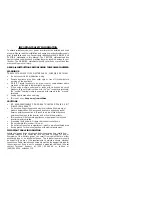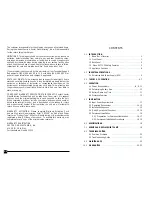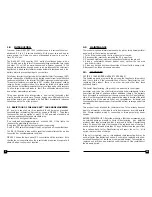
17. Check to ensure that all electrical connections are tight.
18. Ensure that the inverter’s ON/OFF switch is OFF.
19. Insert the fuse into the fuse holder. There may be some sparking.
20. Turn ON the inverter and apply a test load to the AC outlets.
21. Check all connections and tighten any loose connections.
22. Ensure that the battery has an adequate charge. If voltage is low, the
cables may be too long or the gauge too light.
23. If steps 21 and 22 do not correct the problem, contact Vector
Technical Support Department (954) 584-4446 Ext. 119 for
professional direction.
6.0 SPECIFICATIONS
Maximum Continuous Power . . . . . . . . . . .1000 Watts
Surge Capacity (Peak Power) . . . . . . . . . . .2000 Watts
No Load Current Draw (switch on) . . . . . . .0.6 amperes
Max. Efficiency . . . . . . . . . . . . . . Approximately 90%
Input Voltage . . . . . . . . . . . . . . . . . . .10.5–14.7 VDC
Output Voltage . . . . . . . . . . . . . . . . .110 VAC 60 Hz
Low Voltage Alarm . . . . . . . . . . . . . . . . . . .10.6 Volts
Low Voltage Shutdown . . . . . . . . .10.0 Volts Auto Reset
Thermal Shutdown . . . . . . . . . . . . . . . . . . .Auto Reset
Wave Form . . . . . . . . . . .Modified Sine Wave (MSW)
Output Receptacles . . . . . . . . . . . . . . .Three U-ground
. . . . . . . . . . . . . . . . . . . . .
North American standard
Power Transistor Type . . . . . . . . . . . .Siemens MOSFET
Weight . . . . . . . . . . . . . . . . . . . . . .9.26 lbs. (4.2 kg)
Length . . . . . . . . . . . . . . . . . . . .16.14 in. (37.0 cm)
Width . . . . . . . . . . . . . . . . . . . . . . . .9.5 in. (24 cm)
Height . . . . . . . . . . . . . . . . . . . . . . . . .3.3 in. (8 cm)
7.0 SERVICE & PARTS
For service on the inverters, contact the Technical Support Department at:
Vector
™
Manufacturing, Ltd
4140 S.W. 28th Way • Ft. Lauderdale, Florida 33312
Tel. (954) 584-4446 Ext. 119 • Fax (954) 584-5556
• Toll-free: (866) 584-5504
1.3 APPLIANCE CAUTIONS
DO NOT
plug small appliances into the inverter receptacles to directly
recharge their nickel-cadmium batteries. Always use the recharger provided
with that appliance.
DO NOT
plug in battery chargers for cordless power tools if the charger
carries a warning that dangerous voltages are present at the battery terminals.
Not all fluorescent lamps operate properly with this type of inverter. If the bulb
appears to be too bright, or fails to light, do not use the lamp with this inverter.
Some fans with synchronous motors may slightly increase in speed (RPM) when
powered by the inverter. This is not harmful to the fan or to the inverter.
Certain rechargers for small nickel-cadmium batteries can be damaged if
plugged into the inverters. In particular, two types of appliances are susceptible
to damage:
• Small, battery-operated appliances such as flashlights, cordless razors and
tooth brushes that can be plugged directly into an AC receptacle to recharge
• Certain battery chargers for battery packs that are used in some cordless
hand-tools. Chargers for these tools have a warning label stating that
dangerous voltages are present at the battery terminals
DO NOT
use inverters with the above two types of equipment.
The majority of portable appliances do not have this problem. Most portable
appliances use separate transformers or chargers that plug into AC receptacles
to supply a low-voltage DC or AC output to the appliance. If the appliance label
states that the charger or adapter produces a low-voltage DC or AC output (30
volts or less), there should be no problem powering that charger or adapter.
4
19































